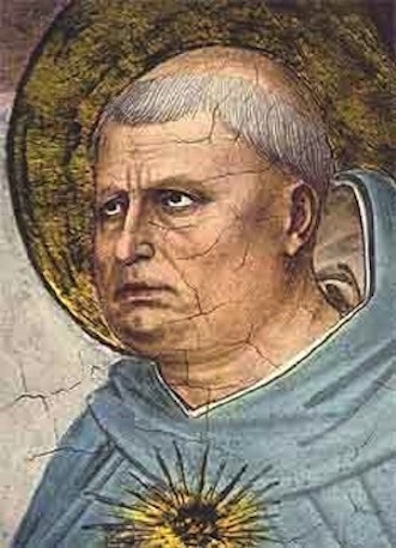Aquinas
Aquinas
In Brief
Forestalling any performance of Stephen's Shakespeare theory until later, Mulligan declares in Telemachus, "I'm not equal to Thomas Aquinas and the fiftyfive reasons he has made to prop it up. Wait till I have a few pints in me first." Stephen thinks of the philosopher in Proteus: "Morose delectation Aquinas tunbelly calls this." When he finally expounds his theory in Scylla and Charybdis, he does not use Aquinian ideas nearly as much as he did in articulating his aesthetic theorizings in A Portrait; but he does refer affectionately to Aquinas as a philosopher “whose gorbellied works I enjoy reading in the original.”
Read More
The “original” of the huge ("gorbellied") Summa Theologica and Summa contra Gentiles is Latin, the language of the medieval Catholic church. Thomas Aquinas (1225-1274) was a Dominican friar and theologian; the Dominicans were as famous for intellectual rigor as the Franciscans were for emotional fervor. The intricately logical Scholastic method of Aquinas’ two big Summae sought to reconcile Aristotelian philosophy with Christian faith. Extremely controversial in his own time, largely because of this synthesis of theistic belief with pagan philosophy, by the end of the 19th century Thomas had become absolutely canonical, recognized as the greatest and most orthodox of all Catholic philosophers. Stephen’s devotion to him has survived the lapse of his faith. In Scylla and Charybdis, Buck Mulligan announces (with “malice”) that “I called upon the bard Kinch at his summer residence in upper Mecklenburgh street [a street in the red-light district] and found him deep in study of the Summa contra Gentiles in the company of two gonorrheal ladies, Fresh Nelly and Rosalie, the coalquay whore.”
It is not only Aquinas' works that are gorbellied. According to popular tradition the philosopher himself was immensely fat, and anecdotes perpetuate the tradition: of holes cut in tables to make room for his belly, of monks unable to carry his dead body down the stairs from his sickroom, and so forth. In Proteus Stephen thinks of him as "Aquinas tunbelly." "Morose delectation" is a translation of Delectatio morosa, which Thornton identifies as one of three internal sins, consisting (according to the Catholic Encyclopedia) of "the pleasure taken in a sinful thought of imagination even without desiring it." He directs readers to three passages in the Summa Theologica.
“Fiftyfive reasons” certainly does suggest Aquinas’ method of breaking large topics down into sub-topics, sub-sub-topics, and sub-sub-sub-topics, then (at the level of the specific question) proposing a statement of his belief, then anticipating the most powerful objection that might be advanced against that belief, then answering it with an “On the contrary,” and finally detailing numerous precise reasons for preferring his position. But it is also possible, Gifford notes, that the number 55 may have been suggested by a detail in Aristotle’s Metaphysics: the claim that beyond the mutable region of the earth and moon lie “fifty-five immutable celestial spheres,” perfectly “circular and changeless.” If so, Joyce is rather naturally associating Aquinas with the cosmological ideas of his master, Aristotle—a philosopher whom Joyce also read with great devotion, and whom Stephen invokes repeatedly in Nestor, Proteus, and Scylla and Charybdis.
Both of these philosophers, like Joyce himself, possessed
highly logical intellects and liked to categorize information.
Joyce once told a friend, “I have a grocer’s assistant’s
mind.” Early in the first chapter of A Portrait, he
has six-year-old Stephen write inside his geography book a
note that charts the categorical levels connecting him to the
highest reaches of the divinely ordered universe:
Stephen Dedalus
Class of Elements
Clongowes Wood College
Sallins
County Kildare
Ireland
Europe
The World
The Universe

